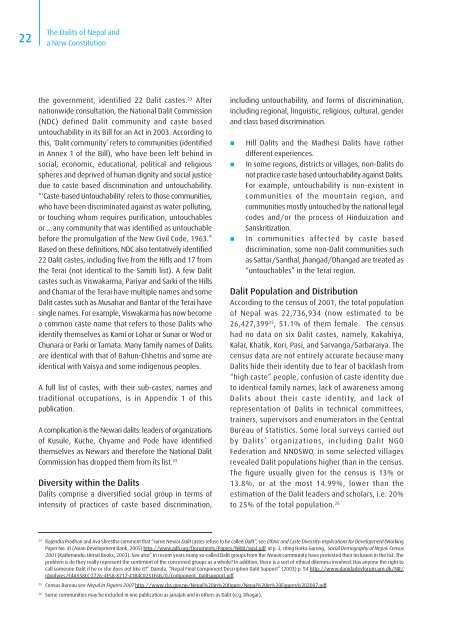The Dalits of Nepal and a New Constitution - ConstitutionNet
The Dalits of Nepal and a New Constitution - ConstitutionNet
The Dalits of Nepal and a New Constitution - ConstitutionNet
Create successful ePaper yourself
Turn your PDF publications into a flip-book with our unique Google optimized e-Paper software.
22<br />
<strong>The</strong> <strong>Dalits</strong> <strong>of</strong> <strong>Nepal</strong> <strong>and</strong><br />
a <strong>New</strong> <strong>Constitution</strong><br />
the government, identified 22 Dalit castes. 23 After<br />
nationwide consultation, the National Dalit Commission<br />
(NDC) defined Dalit community <strong>and</strong> caste based<br />
untouchability in its Bill for an Act in 2003. According to<br />
this, ‘Dalit community’ refers to communities (identified<br />
in Annex 1 <strong>of</strong> the Bill), who have been left behind in<br />
social, economic, educational, political <strong>and</strong> religious<br />
spheres <strong>and</strong> deprived <strong>of</strong> human dignity <strong>and</strong> social justice<br />
due to caste based discrimination <strong>and</strong> untouchability.<br />
“‘Caste-based Untouchability’ refers to those communities,<br />
who have been discriminated against as water polluting,<br />
or touching whom requires purification, untouchables<br />
or …any community that was identified as untouchable<br />
before the promulgation <strong>of</strong> the <strong>New</strong> Civil Code, 1963.”<br />
Based on these definitions, NDC also tentatively identified<br />
22 Dalit castes, including five from the Hills <strong>and</strong> 17 from<br />
the Terai (not identical to the Samiti list). A few Dalit<br />
castes such as Viswakarma, Pariyar <strong>and</strong> Sarki <strong>of</strong> the Hills<br />
<strong>and</strong> Chamar <strong>of</strong> the Terai have multiple names <strong>and</strong> some<br />
Dalit castes such as Musahar <strong>and</strong> Bantar <strong>of</strong> the Terai have<br />
single names. For example, Viswakarma has now become<br />
a common caste name that refers to those <strong>Dalits</strong> who<br />
identify themselves as Kami or Lohar or Sunar or Wod or<br />
Chunara or Parki or Tamata. Many family names <strong>of</strong> <strong>Dalits</strong><br />
are identical with that <strong>of</strong> Bahun-Chhetris <strong>and</strong> some are<br />
identical with Vaisya <strong>and</strong> some indigenous peoples.<br />
A full list <strong>of</strong> castes, with their sub-castes, names <strong>and</strong><br />
traditional occupations, is in Appendix 1 <strong>of</strong> this<br />
publication.<br />
A complication is the <strong>New</strong>ari dalits: leaders <strong>of</strong> organizations<br />
<strong>of</strong> Kusule, Kuche, Chyame <strong>and</strong> Pode have identified<br />
themselves as <strong>New</strong>ars <strong>and</strong> therefore the National Dalit<br />
Commission has dropped them from its list. 24<br />
Diversity within the <strong>Dalits</strong><br />
<strong>Dalits</strong> comprise a diversified social group in terms <strong>of</strong><br />
intensity <strong>of</strong> practices <strong>of</strong> caste based discrimination,<br />
including untouchability, <strong>and</strong> forms <strong>of</strong> discrimination,<br />
including regional, linguistic, religious, cultural, gender<br />
<strong>and</strong> class based discrimination.<br />
• Hill <strong>Dalits</strong> <strong>and</strong> the Madhesi <strong>Dalits</strong> have rather<br />
different experiences.<br />
• In some regions, districts or villages, non-<strong>Dalits</strong> do<br />
not practice caste based untouchability against <strong>Dalits</strong>.<br />
For example, untouchability is non-existent in<br />
communities <strong>of</strong> the mountain region, <strong>and</strong><br />
communities mostly untouched by the national legal<br />
codes <strong>and</strong>/or the process <strong>of</strong> Hinduization <strong>and</strong><br />
Sanskritization.<br />
• In communities affected by caste based<br />
discrimination, some non-Dalit communities such<br />
as Sattar/Santhal, Jhangad/Dhangad are treated as<br />
“untouchables” in the Terai region.<br />
Dalit Population <strong>and</strong> Distribution<br />
According to the census <strong>of</strong> 2001, the total population<br />
<strong>of</strong> <strong>Nepal</strong> was 22,736,934 (now estimated to be<br />
26,427,399 25 , 51.1% <strong>of</strong> them female. <strong>The</strong> census<br />
had no data on six Dalit castes, namely, Kakahiya,<br />
Kalar, Khatik, Kori, Pasi, <strong>and</strong> Sarvanga/Sarbaraiya. <strong>The</strong><br />
census data are not entirely accurate because many<br />
<strong>Dalits</strong> hide their identity due to fear <strong>of</strong> backlash from<br />
“high caste” people, confusion <strong>of</strong> caste identity due<br />
to identical family names, lack <strong>of</strong> awareness among<br />
<strong>Dalits</strong> about their caste identity, <strong>and</strong> lack <strong>of</strong><br />
representation <strong>of</strong> <strong>Dalits</strong> in technical committees,<br />
trainers, supervisors <strong>and</strong> enumerators in the Central<br />
Bureau <strong>of</strong> Statistics. Some local surveys carried out<br />
by <strong>Dalits</strong>’ organizations, including Dalit NGO<br />
Federation <strong>and</strong> NNDSWO, in some selected villages<br />
revealed Dalit populations higher than in the census.<br />
<strong>The</strong> figure usually given for the census is 13% or<br />
13.8%, or at the most 14.99%, lower than the<br />
estimation <strong>of</strong> the Dalit leaders <strong>and</strong> scholars, i.e. 20%<br />
to 25% <strong>of</strong> the total population. 26<br />
24<br />
Rajendra Pradhan <strong>and</strong> Ava Shrestha comment that “some <strong>New</strong>ar Dalit castes refuse to be called Dalit”, see Ethnic <strong>and</strong> Caste Diversity: Implications for Development (Working<br />
Paper No. 4) (Asian Development Bank, 2005) http://www.adb.org/Documents/Papers/NRM/wp4.pdf, at p. 3, citing Harka Gurung, Social Demography <strong>of</strong> <strong>Nepal</strong>: Census<br />
2001 (Kathm<strong>and</strong>u: Himal Books, 2003). See also” In recent years many so-called Dalit groups from the <strong>New</strong>ar community have protested their inclusion in the list. <strong>The</strong><br />
problem is do they really represent the sentiment <strong>of</strong> the concerned groups as a whole? In addition, there is a sort <strong>of</strong> ethical dilemma involved: Has anyone the right to<br />
call someone Dalit if he or she does not like it?” Danida, “<strong>Nepal</strong> Final Component Description Dalit Support” (2003) p. 54 http://www.danidadevforum.um.dk/NR/<br />
rdonlyres/E4A558CC-2726-4E58-8717-41B4C0251F6B/0/Component_<strong>Dalits</strong>upport.pdf.<br />
25<br />
Census Bureau see <strong>Nepal</strong> in Figures 2007 http://www.cbs.gov.np/<strong>Nepal</strong>%20in%20figure/<strong>Nepal</strong>%20in%20Figures%202007.pdf.<br />
26<br />
Some communities may be included in one publication as janajati <strong>and</strong> in others as Dalit (e.g. Dhagar).








![g]k fnsf blntx? / gofF ;+l jwfg](https://img.yumpu.com/49483602/1/184x260/gk-fnsf-blntx-goff-l-jwfg.jpg?quality=85)



![+ljwfg;ef, /fHosf]k'g](https://img.yumpu.com/41604075/1/184x260/-ljwfgef-fhosfkg.jpg?quality=85)




